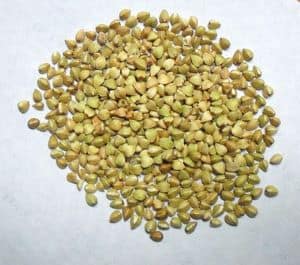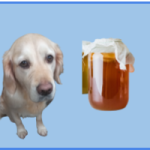There is quite a lot of buzz around buckwheat, at least among those interested in superfoods and their health benefits.
Indeed, buckwheat is an excellent source of fiber and minerals, and you should include it in your diet.
As for the question – can dogs eat buckwheat? – the answer is yes, they totally can. Buckwheat seeds make a a great addition to your dog’s regular diet.
In this article, we’ll examine what exactly buckwheat is, how to cook it – including a yummy puppy pancake recipe.
If you’re considering growing buckwheat in your garden, be very careful though – the plant is toxic to dogs!
What is buckwheat?
Its name is deceiving, buckwheat is not related to wheat in any way and it’s not even a type of grass (or cereal).
Buckwheat is a seed, just like quinoa or chia. It can be used instead of wheat, which makes it a pseudocereal.
Buckwheat is a short-season crop and it originates in China, where it was first cultivated some 8,000 years ago.
Buckwheat seeds are brown and have a triangular shape.
They have a nutty, slightly bitter taste
Buckwheat can be cooked in many ways.
Dehulled seeds can be cooked like rice, a dish known as buckwheat groats.
Buckwheat flour is a great substitute for regular flour as it is gluten-free.
A popular Asian dish made with this flour are soba noodles.
Soba means buckwheat in Japanese.
What are the nutritional benefits of buckwheat?
A 100g serving of cooked buckwheat provides 145 calories.
As a seed, it is packed with protein – 5g in one serving, but low in fat (1.5g per 100g).
The same serving contains 27g of carbs, and the sugar content is negligible.
What makes buckwheat particularly recommended for dogs is the fact that it is a valuable source of fiber – 1.5g per 100g – and this is of great help for dogs suffering from constipation.
Buckwheat is being touted as a superfood because it is very rich in minerals.
For instance, 100g of buckwheat provides 75mg of magnesium, which is over 20% of the recommended daily value for humans.
Magnesium is important for bone health and supports energy levels.
It also has a high content of manganese, copper iron and phosphorus.
Manganese helps activate various enzymes in the body, including those associated with digestion.
As for copper, it supports production of blood cells, both red and white, and this sustains a strong immune system.
On the other hand, buckwheat is not a good source of vitamins, except for traces of B vitamins.
One of the things that makes buckwheat a superfood is a phytonutrient called rutin, associated with a reduced risk of heart disease, in both humans and dogs.
Buckwheat also contains polyphenol, an antioxidant that combats cellular damage caused by free radicals.
Another antioxidant found in buckwheat is quercetin, which has been shown to reduce the risk of cancer and heart disease.
What are the health benefits of buckwheat for dogs?
Adding buckwheat groats to your dog’s food or preparing doggy treats with its flour provides many health benefits to your dog.
Promotes colon health
Buckwheat contains a decent amount of fiber, and also a resistant starch which improves digestion.
Resistant starches are not digested, but they are fermented by the bacteria in the dog’s guts which produce short-chain fatty acids (SCFA).
This type of fatty acids are important as they feed the cells that form the intestinal lining. Gut health is essential for your dog, as it slashes the risks of colon cancer.
Fights diabetes
Buckwheat is recommended for people and dogs suffering from Type 2 diabetes, as it has a low glycemic index.
Also, the high fiber and protein content decreases blood sugar levels.
Another reason buckwheat is effective in controlling diabetes is that it contains a unique compound called D-chiro-inositol, which makes cells more sensitive to insulin.
Controls weight gain
Being rich in fiber and protein, buckwheat will make your dog feel full for a longer period, so he won’t be bothering you for unhealthy and highly-calorific treats.
However, you need to feed your dog buckwheat in moderation.
Recommended for dogs allergic to gluten
Buckwheat flour can be successfully used as a flour substitute, which allows dogs allergic to gluten to enjoy special treats like any other pet.
But you need to keep in mind that some dogs can be allergic to grains.
When you feed your dog buckwheat for the first time, monitor him for a couple of hours to make sure he doesn’t develop an allergic reaction.
Also, watch out for signs of an upset stomach.
If you buy buckwheat from the store, in whatever form, check the label for additives, which can create various health issues.
What is buckwheat poisoning?
As mentioned before, buckwheat seeds are safe for human and dog consumption. The buckwheat plant is a completely different story.
Buckwheat goes by the scientific name of Fagopyrum Esculentum.
Its name comes from the fact that it contains fagopyrin, which is a toxin that induces photosensitivuty, a painful reaction to sunlight exposure.
This compound can be found in buckwheat leaves, but not in the plant itself or the seeds.
Buckwheat poisoning causes photophobia (fear of sunlight), skin rashes, swelling, lesions that can develop into full-blown skin necrosis, or death of skin tissue.
If you sprinkle a few buckwheat leaves on your salad, you probably won’t feel any side-effects.
Yet, if your dog develops a taste for buckwheat leaves from the plants in your garden, he might be poisoned.
Buckwheat poisoning is not deadly and the effects will go away in a few days, during which you should keep your dog away from direct sunlight.
If he develops painful skin lesions, go see a vet to avoid infection.
Keep in mind that cooking at high temperatures doesn’t reduce fagopyrin toxicity, so it’s best to throw them away.
Put them in a sealed bag, just in case your dog decides to raid the trash can.
How to prepare buckwheat for your dog?
That depends on what you want to make using buckwheat.
Buckwheat groats
To make this, you need roasted buckwheat seeds.
- Rinse the seeds to remove debris
- Put 1 part seeds and 2 parts water in a pan
- Let it simmer on the stove for 10-15 minutes.
You can pour some buckwheat groats on top of your dog’s food, whether it’s dry or wet.
Keep in mind that there are 145 calories in 100g of buckwheat so you might want to reduce the amount of normal food you put in the dog’s bowl.
Puppy pancakes
For this recipe you will need some buckwheat flour, which can be easily prepared by throwing some seeds in a food processor.
Ingredients:
- 1 egg
- ½ cup of buttermilk
- 2 tbsp peanut butter
- ½ cup buckwheat flour
- 2 tbsp quick cook polenta
- ½ tsp baking powder
- Coconut oil (or, fail that, whatever cooking oil you have at hand)
How to make pancakes
- Break the egg in a large bowl and beat it a few seconds using a hand mixer
- Mix in the peanut butter and butter milk
- Add the flour, baking powder and polenta and mix until you get a thick pancake batter. If it’s too thick, add a bit of water
- Cook the pancakes on an oiled griddle at medium heat until they get golden brown. Flip and cook for one more minute.
You can serve your dog this super healthy treat plain, or you can add a bit of peanut drizzle.
Can dogs eat grains?
Dogs can eat grains as they are generally safe. However, when you decide to add grains to your dog’s staple diet you should look for those that have some health benefits.
Oats and brown rice are among the best types of grains for a dog, as they are full of essential nutrients and a good source of fiber.
Oats are a low calorie food, and they are very good at preventing heart disease, so they are particularly suitable for elderly dogs.
Brown rice has a high fiber content and is rich in manganese, magnesium and antioxidants.
Quinoa seeds are also suitable for dogs and they provide a healthier alternative to wheat, corn and soy. Quinoa seeds tend to be bitter so you may want to disguise the taste by mixing them with more palatable foods.
Chia seeds are also very healthy, as they are loaded with minerals and vitamins. They can be served as such, grounded or cooked.
What you should keep in mind though is that grains should not substitute a normal meat-based diet. Grains make a healthy addition to your pet’s meal, but a dog is supposed to eat meat primarily.
Closing thoughts
Dogs can and should eat buckwheat, at least from time to time. Buckwheat seeds can be cooked or ground into flour, which can be used to make a variety of treats.
Feeding your dog buckwheat has many health benefits, as these seeds are rich in fiber and many minerals.
Adding buckwheat to your dog’s regular diet can improve colon health, prevent and control diabetes, and promote heart health.
If you grow buckwheat in your garden, enclose the area with a high fence as the leaves of the plant contain a toxin that causes photosensitivity in dogs.






